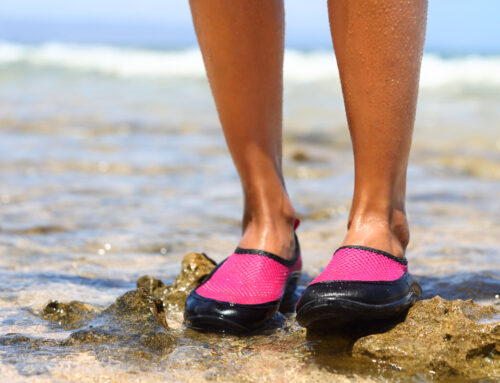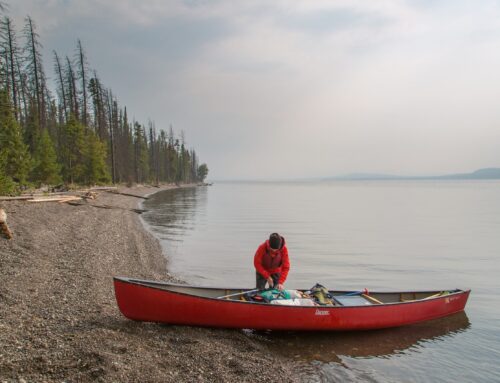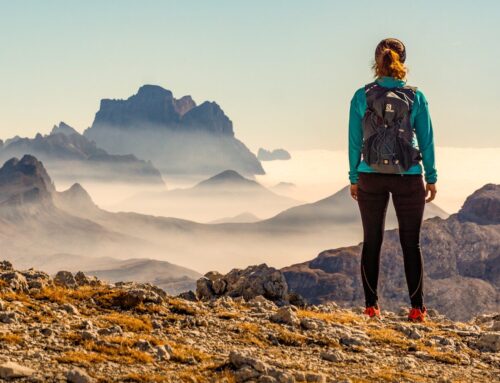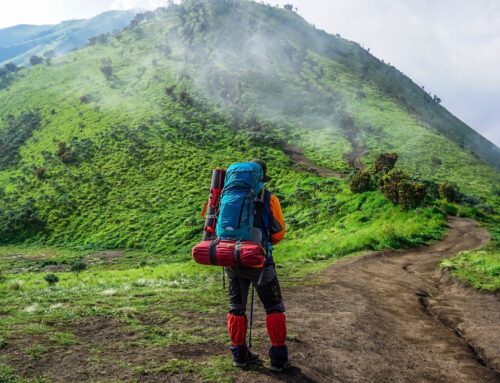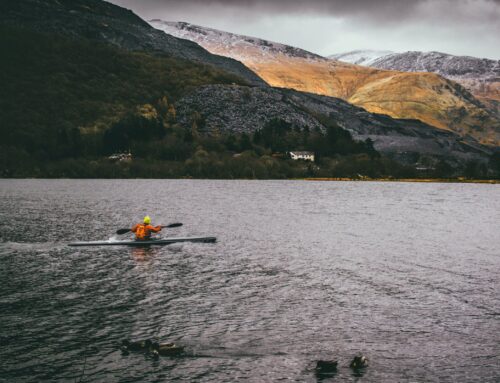Updated December 2, 2022
Bouldering is one of the most fun and challenging climbing disciplines, and it’s having a moment right now. People all over the world are flocking to bouldering gyms and local climbing hideouts to get a taste for this rope-free climbing lifestyle. One of the biggest draws of bouldering is that you really only need shoes (and maybe some chalk and a chalk bag) to do it. Because shoes are so important in bouldering, it’s critical to get yourself a solid pair, especially when you’re just starting out. We’ve created this in-depth guide to the best bouldering shoes for beginners to help you choose the perfect pair for your preferences and skill level.
Want to learn more?
- 30 Super Practical and Clever Gifts for Climbers
- 15 Essential Bouldering Tips for Beginner Climbers
- What is Bouldering? Everything You Need to Know Before You Go
Renting vs. Buying Climbing Shoes: Why Buy?
Most people typically rent shoes their very first time climbing in a gym. Many gyms even include the cost of shoes in their price of admission. While this is an easy and cost-effective option for beginners who aren’t sure if they want to climb regularly, rental shoes can often inhibit your progression as you get better and better at climbing.
Instead, we recommend buying your first pair of beginner bouldering shoes once you’ve joined a climbing gym or made a conscious decision to climb regularly. When you buy shoes, you can find a pair that fits your feet better than rentals and is more suited to your specific needs. A good pair of beginner bouldering shoes will enable you to progress quickly without sacrificing comfort or providing too many unnecessary bells and whistles.
Our picks for the best bouldering shoes for beginners are below, but we’d strongly recommend reading our list of things to consider when buying climbing shoes before diving into our recommendations.

Best Bouldering Shoes for Beginners & First Timers: Our Picks
When evaluating the best beginner bouldering shoes, we put ourselves into the figurative shoes of a first-time climber. We wanted to ensure that our recommendations were realistic and practical.
What we determined is that there are key criteria that a beginner should look for, namely fit, materials, and price. At a minimum, your first pair of shoes for bouldering should be snug but comfortable, and shouldn’t cost an arm and a leg. In line with these, our recommendations here include the best of the best shoes at the most attainable price points.
- Best Bouldering Shoes for Beginners: Evolv Defy & Elektra
- A Close Runner Up: La Sportiva Tarantulace
- Most Versatile Bouldering Shoes for Beginners: Butora Endeavor
- Best Premium Beginner Bouldering Shoes: Scarpa Force V
- Best Step-Up Shoe: La Sportiva Miura VS
- Honorable Mentions: Black Diamond Momentum, Scarpa Origin, Mad Rock Drifter, Evolv Kronos & Kira, Scarpa Veloce, La Sportiva Finale
Evolv Defy & Elektra
Best Beginner Bouldering Shoes
- Materials: Leather upper; TRAX high-friction rubber outsole
- Closure: Lace or Velcro
- MSRP: $99 ($89 with velcro)
- In A Nutshell: Soft, comfortable, and flexible, these shoes are ideal for learning how to boulder indoors or outside
Planning on bouldering for the first time? The Evolv Defy (men) & Elektra (women) are our picks for the best beginner bouldering shoes on the market. Our founder loves these shoes so much, she uses them regularly at her own bouldering gym! With a soft, snug fit and grippy soles, these shoes are fantastic for those who are learning to boulder indoors or outside. Moreover, the extra flexibility in the sole will help you build foot strength and technique early-on.
We’ve chosen these shoes for bouldering because they’re super comfortable and well rounded. The TRAX rubber soles are excellent for learning smearing and working with tiny toe holds, and the upper offers one of the most comfortable climbing shoe fits we’ve encountered. Combined, these characteristics offer structure and stability for new climbers who are just getting their footing in the sport.
While this is a fantastic shoe for bouldering beginners, the neutral aggressiveness and flexibility may eventually inhibit your growth in bouldering down the road. However, as a first pair of bouldering shoes, we’d wholeheartedly recommend the Evolv Defy & Elektra.
CHECK EVOLV DEFY PRICES HERE:
CHECK EVOLV ELEKTRA PRICES HERE:
La Sportiva Tarantulace
A Close Runner Up
- Materials: Leather upper; FriXion rubber outsole
- Closure: Laces
- MSRP: $85
- In A Nutshell: Affordable, durable, comfortable option for those starting off in bouldering
Take one look around the climbing gym and you’ll probably spot a handful of folks sporting La Sportiva’s Tarantulace shoes. It’s no surprise that this beginner-friendly shoe is so popular – it’s high-quality, comfortable, and affordable, the perfect combination for those wanting to dip their toes (pun intended) into the world of bouldering.
Best for gyms and beginner-level outdoor climbing, the La Sportiva Tarantulace is an ideal choice for those who are buying their very first pair of climbing shoes. It’s built for comfort and wearability, avoiding the foot pain typically associated with more advanced shoe types. We’ve chosen the Tarantulace as our pick for the best beginner bouldering shoes because they offer everything an early-stage climber needs at a great price.
What this model doesn’t offer is top-of-the-line materials (the FriXion sole isn’t the stickiest) or technical capabilities, which means you may find them difficult to use once you’ve reached a certain skill level. However, for those looking for an entry-level shoe that will support you in your early days while you learn critical climbing techniques, the La Sportiva Tarantulace is an exceptional choice.
Butora Endeavor
Most Versatile Bouldering Shoes for Beginners
- Materials: Suede & leather upper, Butora rubber outsole
- Closure: Velcro
- MSRP: $110
- In A Nutshell: This versatile shoe is a fantastic option for folks wanting to split time bouldering & rope climbing
Looking for the perfect fit? Cue the Butora Endeavor, one of the best beginner bouldering shoes for folks wanting to try out climbing in more comfortable footwear. This hardy, durable shoe is great for indoor or outdoor climbing and offers more long-term potential as you excel at climbing with its slightly downturned last. Combining performance, comfort, and a reasonable price, don’t overlook this solid shoe when considering the best bouldering shoes for beginners.
One thing we love the most about Butora climbing shoes is that they come with different fit options for wide, regular, and narrow feet. This means basically any climber can find a precise fit in the Butora Endeavor shoes. These shoes are designed to feel really good on the feet, meaning you can climb a long time without having to pull your shoes on and off while cringing in pain.
Scarpa Force V
Best Premium Bouldering Shoes for Beginners
- Materials: Suede leather upper; Vibram XS edge rubber outsole
- Closure: Velcro
- MSRP: $159
- In A Nutshell: While these are a bit of a splurge, it’s worth it for beginners seeking premium comfort and support
Those who value comfort and quality will be hard-pressed to find more luxe bouldering shoes for beginners than the Scarpa Force V (and the equivalent women’s version). Made with plush suede and grippy Vibram soles, these shoes are an excellent choice for beginners. From the time you put them on, you’ll be able to feel how much more padded and cozy these shoes fit as compared to other, more minimal options on our list. For climbers who have never put their feet into awkward, tight shoes (like most climbing shoes), these offer a respectable alternative.
As the most expensive option on our list, the Scarpa Force V is truly an investment in your comfort. And with the premium materials and design (plus a more comfortable climber), you’ll likely see these perform slightly better than some of the no-frills beginner models we share.
La Sportiva Miura VS
Best Step-Up Bouldering Shoe
- Materials: Leather upper; Vibram XS Edge rubber outsole
- Closure: Velcro
- MSRP: $199
- In A Nutshell: A top-notch step-up shoe for advanced beginners & intermediate climbers tackling indoor and outdoor bouldering routes
We don’t have enough good things to say about the La Sportiva Miura VS (and the equivalent women’s version) for advanced beginners and intermediate climbers. While this isn’t technically a beginner bouldering shoe, it’s a reasonable step up for new climbers who are progressing quickly in their skill level and route difficulty. Designed to be suitable for indoor and outdoor climbing, the Miura VS boasts a stiff sole, durable leather uppers, and a performance-oriented downturned design. It’s also got excellent Vibram XS Edge soles for optimal stickiness on tiny footholds.
Because of its superior build, the Miura VS is our absolute favorite climbing shoe for women and one of our top picks of all climbing shoes out there. It’s certainly not for climbers just getting started, but if you’ve built up your skills and feel ready for a shoe to uplevel your bouldering game, the Miura VS may just be the perfect shoe companion for you.

Honorable Mentions
Black Diamond Momentum
- Materials: Knit synthetic upper; rubber outsoles
- Closure: Velcro (with a lace version)
- MSRP: $99.95
- In A Nutshell: A decent beginner bouldering shoe sporting a comfy but progression-inhibiting design
A frequent flyer at the climbing gym, the Black Diamond Momentum (and the equivalent women’s version) is one of the most popular bouldering shoes for beginners. Black Diamond is no stranger to the climbing world, offering a range of gear for beginner climbers to advanced mountaineers. The Momentum is a unique shoe because it has a synthetic knit upper, offering lightweight breathability in comparison to the leather and closed synthetic designs on our list.
The biggest downside to the Momentums? They’re not the best for quick progression. One of the reasons why the Black Diamond Momentum is such a popular choice is because it is often sold in a beginner climbing kit, including a harness and belay device. What this means in practice, though, is a somewhat one-size-fits-all design approach, with a little too much wiggle room for the precision required as you advance as a climber. We feel that this is a shoe that could quickly hold you back from more difficult routes, but if you’re looking for a starter gym shoe that’s breathable and roomy, the Momentum could be a good choice.
Scarpa Origin
- Materials: Suede leather upper; Vision rubber outsole
- Closure: Velcro
- MSRP: $115
- In A Nutshell: Scarpa’s entry-level shoe boasts superior construction, but with minimal room for growth
There are few climbing shoes for beginners as well-designed as the Scarpa Origin (and the equivalent women’s version). Created to address the growing entry-level climbing community, the Origin was designed with comfort and durability in mind. Made from soft suede uppers and grippy soles, the Origin is a fantastic companion for any new climber looking to gain experience in a trusted pair of shoes.
We’ve tested the Scarpa Origin extensively in comparison to La Sportiva’s competitor, the Defy/Elektra, and La Sportiva had the edge with its comfort and softness (a plus when you’re learning to climb). While the Origin was clearly very well-designed and made of fantastic materials, it was a bit more rigid and tight around the toes. However, you really can’t go wrong with the Scarpa Origin, and we’d wholeheartedly recommend it to anyone looking to invest in their first pair.
Mad Rock Drifter
- Materials: Leather upper; Science Friction rubber sole
- Closure: Velcro
- MSRP: $75
- In A Nutshell: This no-frills shoe is a decent value option (if not slightly flimsy) for beginners on a budget
If you’re looking for a pair of climbing shoes at the cheapest price, the Mad Rock Drifter is a common choice for climbers who are just starting out. At an MSRP of $75, this is the lowest-priced shoe on our list, and with a leather upper and snug construction, it’s a decent choice for climbers.
However, as with many other types of outdoor gear, you get what you pay for with these. The build has been reported to be a bit less durable than other shoes, wearing out quickly with regular use. While the Mad Rock Drifter is a decent first pair, for regular climbers, we’d recommend spending the extra $10 and getting the La Sportiva Tarantulace, which is a much better and more reliable shoe in our experience.
Evolv Kronos & Kira
- Materials: Synthratek VX synthetic upper; TRAX SAS high-friction rubber outsole
- Closure: Velcro
- MSRP: $135
- In A Nutshell: A comfortable yet solid fully synthetic step-up shoe for folks who learn and progress quickly
As climbers, it’s always a bittersweet feeling when we outgrow our gear, and that can happen quickly when you’re spending a lot of time at the gym or on the crag. Luckily, the Evolv Kronos (men) & Kira (women) exist for people just like you, as their utility extends beyond the first few steps in bouldering or trad climbing. Unlike the Defy/Elektra, these shoes take on a slightly more advanced build, which is advantageous for more difficult overhang climbs and technical routes.
With high-quality synthetic uppers, an easy-to-use velcro closure, and a grippy TRAX rubber sole, these have all the bells and whistles necessary for ambitious beginner climbers wanting shoes that won’t inhibit them. Moreover, these slightly downturned shoes are built for progression into the intermediate stages of climbing. However, they’re comfortable enough for beginners to feel confident early-on, as opposed to other more advanced models which can hurt quite a bit to wear.
CHECK EVOLV KRONOS PRICES HERE:
CHECK EVOLV KIRA PRICES HERE:
Scarpa Veloce
- Materials: Synthetic upper; proprietary S-72 rubber outsole
- Closure: Velcro
- MSRP: $159
- In A Nutshell: Excellent intermediate step-up shoe for indoor bouldering; best moderate level vegan option
A strong contender for the best step-up bouldering shoe, the Scarpa Veloce is a seriously incredible design feat. This moderate shoe boasts high-quality synthetic uppers, a convenient velcro closure, and a soft, flexible build perfect for indoor climbing. In fact, the Veloce was designed and built specifically for indoor use, and because of this, you’ll find it’s a more comfortable alternative than the stiff, outdoor-focused La Sportiva Miura VS. If you primarily climb indoors, we’d recommend upgrading to the Veloce over the Miura VS.
La Sportiva Finale
- Materials: Leather upper; Vibram XS Edge rubber outsole
- Closure: Laces
- MSRP: $129
- In A Nutshell: Fantastic beginner-friendly performance shoe with possible heel issues
For ambitious beginners hoping to progress to tough grades quickly, the La Sportiva Finale (and the equivalent women’s version) is one of the best bouldering shoes for beginners. Thick, sturdy soles with Vibram XS Edge rubber (our favorite for grippiness) make these a solid choice for beginner climbers, while an unlined leather upper offers durable comfort and minimizes foot pain. There’s a lot to love about this shoe, but our favorite thing about it is that it’s built to last from the first days through the intermediate stages of a climber’s journey.
Built for versatility, the Finale performs indoors and outdoors for both roped climbs as well as bouldering problems. Its thick sole and leather upper offers lots of durability for high-volume climbing, but this may require a longer break-in period for the shoes to stretch and accommodate your feet. Like other performance-oriented beginner shoes, the slight downturn offers more longevity for the shoe as you progress, making the $109 price tag well worth it.
Many users have complaints about the heel of the La Sportiva Finale, which is what knocked it down on our list. When we tested this shoe, we did find that the women’s version had a bit of a baggy heel, made uncomfortable by the design of the rubber in the back. We wouldn’t knock this shoe completely, however; we’d recommend trying it on and determine for yourself if the heel design is an issue.

Best Beginner Bouldering Shoes: What to Look For
Buying your first pair of climbing shoes can feel like a daunting task given the number of great options out there. A lot of the vocabulary used to discuss climbing shoe designs may feel foreign to you, and thanks okay! We’ll break down everything you need to know about shoe designs and fit in this section so you’ll have a basic foundation for what to look for and ask about when you’re ready to buy.
Generally, beginner bouldering shoes are a) the cheapest and b) the flattest of all of the shoes at any retailer. Beginner shoes typically have roomy toe areas and a simpler design than more technical options. The more rounded, pointy (and expensive) shoes are useful for advanced outdoor climbers who need as much precision and performance as they can get. While beginners could use these, they’re much tighter and less comfortable and will provide too many technical features for those just starting off. (To be clear: we do not recommend starting off with a super downturned shoe!)
Gym Climbing vs. Outdoor Climbing
Whether you want to climb indoors or outdoors may affect the shoes you’ll want to consider. After all, conditions and mileage do vary when comparing gym climbing with outdoor climbing. While any pair of shoes will work for both, some shoes will perform better at the gym while others shine outside.
Gym Climbing
For climbers who plan to primarily climb indoors, you’ll want to look for a shoe that’s comfortable and durable, as you’ll be logging more climbs more quickly than outdoors. True “beginner” shoes with a neutral aggressiveness, thick soles, and more comfortable features are best suited for indoor climbing. Additionally, you may want to consider a Velcro option for easy on-and-off access at the gym. Flexible, soft shoes are much more appropriate for indoor climbing because they’ll help you built foot strength and technique early in your climbing journey.
Outdoor Climbing
Outdoor climbing generally requires a bit more precision and technique than indoor climbing, and this is where a bit of downturn and stiffer soles can be more useful. Footholds can be small and much more daunting, and having a pair of bouldering shoes for beginners that can support you in tricky situations can provide confidence and security. While you’ll probably end up climbing in the gym before heading outdoors, if your endgame is to get out in fresh air, it’s wise to consider a more technical pair of shoes like the La Sportiva Finale or the Miura VS.
Snug (But Not Painful) Fit
You may hear conventional advice telling you to buy the tightest shoes you can cram your foot into. As you get more advanced in your climbing skills, you can opt for a more performance-oriented, tight-fitting shoe. However, at the beginner level, we’d recommend opting for a shoe that fits snugly without feeling constrictive.
Like we mentioned above, beginners are likely to look for different characteristics in a shoe than more advanced climbers. The #1 most important thing for beginners to remember is that a shoe’s fit is the most crucial aspect to consider. In the beginning, you’ll be developing your strength and technique, and an ill-fitting shoe that hurts to wear or, conversely, flops around will only hinder your progress. Instead, we recommend seeking a shoe with little wiggle room that still fits comfortably enough to wear for several hours at a time.
The only way to truly know whether or not a shoe is a good fit for you is to try it on. You’ve got a couple of options here: either go into a local retail shop or climbing gym and try on different pairs of shoes, or order several pairs and then return the ones that don’t fit well. Typically, you’ll want to order your own street shoe size and then size up by half-sizes from there.
Upper Materials
The “uppers,” or foot-facing materials, are a critical component of any beginner bouldering shoes. You’ll find different types of upper materials on our list, namely leather/suede, synthetic, and knit uppers. What you choose for your first pair of shoes comes largely down to preference. Essentially, there are arguments for and against different types of upper materials for a shoe.
Leather and Suede
Leather and suede uppers will stretch and conform to your feet over time, but typically require a break-in period to get to that point. Because of their durability, these are the best bouldering shoes for beginners, and you’ll find that the vast majority of high-end climbing shoes are made of leather uppers. Many climbers find leather uppers to be the most comfortable as well. Leather is generally our choice when it comes to buying any climbing shoes, but for beginners, this isn’t quite as important, since you’ll probably upgrade your shoes before it matters in a significant way.
Synthetic and Knit
Synthetic uppers are a vegan-friendly choice and generally do not stretch, making them a great plug-and-play option. You won’t have as much of a break-in time or an adjustment period with synthetic shoes. However, they are typically less durable over time and often develop a stink to them that’s less prevalent in leather shoes. Evolv’s Defy/Elektra and Kronos/Kira all have synthetic uppers and they’re some of our favorite choices for the best beginner bouldering shoes.
Knit uppers, like those found in the Black Diamond Momentum, are the most breathable choice, but are the least durable of all. These aren’t very common but you may see them from time to time – we’d generally recommend synthetic or leather uppers before knit ones.
Soles
We’re going to go out on a limb here and say that, in our opinion, the type of rubber on the sole doesn’t matter as much as the thickness of the rubber. What I mean to say with this is that there are certain types of rubber – Vibram’s XS Edge being a prime example – that are known for maximum grip, while others – like FriXion – which are less sticky but last longer.
For gym climbers, opting for a thicker sole is key because you’ll typically burn through more routes, more quickly indoors. Outdoor climbing can be a little more nuanced, as you’ll climb less but face grittier conditions in your shoes. In general, we’d shoot for anything 3.5mm and up, and if you can snag a shoe with TRAX or Vibram rubber, you’ll have an easier time progressing, smearing, and performing on smaller holds.

Closure: Laces vs. Velcro
So you’ve chosen a shoe with a robust sole and a durable upper. Now what? You’ll have to decide on a closure. There are three types of closures you’ll see on climbing shoes – velcro, shoelaces (lace), and slip ons. We don’t usually recommend slip ons because their fit can’t be adjusted like Velcro or lace closures can. But Velcro and laces have their own benefits, and many climbers tend to prefer one style over the other.
For fine-tuned comfort and performance, laces are the way to go. Laces are a lot more precise than velcro, and can be adjusted based on your personal preferences. Additionally, they can compensate for areas of the shoe that may be tighter or looser based on your unique foot shape. However, they are less efficient, taking more time to put your shoes on and take them off. Outdoor climbers generally prefer laces because they’re more streamlined than Velcro.
Velcro, on the other hand, is the mothership of convenience. You can take your shoes off and put them back on with ease, which is especially helpful during the break-in period when your feet are starting to hurt. Moreover, they require less time and effort to adjust, although can be more limited in customization by the closure design. Velcro also wears out over time and can be less durable than laces in certain situations.
If you look carefully, you’ll notice that a lot of shoes have Velcro and lace versions, so you can have your pick depending on your personal preferences.
Downturn/Aggressiveness
As a beginner, you’ll generally want a flat/neutral or slightly downturned shoe. Your shoes should not look like bananas as a first-time climber. Most climbers start off with a completely neutral shoe, then opt for more downturn/aggressiveness over time. Some climbers who plan to climb often and progress quickly may choose a slightly downturned option, like the Evolv Kronos/Kira, to start so they can progress without having to upgrade. Either way, don’t get ahead of yourself by choosing a super aggressive shoe to start with – it’ll only cause your foot more pain than necessary and hinder your learning and development.
Softness
The final characteristic you may hear about is “softness.” Shoe softness refers to how bendy or flexible the shoe is, versus solid and rigid. In general, we’d recommend a softer shoe for learning to climb because it will help you strengthen your foot muscles and build technique without relying on your shoes completely. For bouldering and gym climbing, a soft shoe can be especially helpful and versatile. Longer routes may require a more rigid shoe for stability and support.
Additional Resources
What to Bring Rock Climbing
- Climbing shoes – Climbing shoes are the #1 most important piece of gear you need for any kind of rock climbing. We always recommend buying your own shoes (rather than renting) for those planning to climb regularly.
- Chalk – Chalk helps fortify your hand grip on the wall. Many gyms do not offer free chalk to climbers, so we’d recommend bringing your own chalk in a portable chalk bag you can strap around your waist on longer climbs.
- Harness/belay device – If you’re planning on climbing with ropes, you’ll need a harness and a belay device (note that some gyms have these pre-installed). Check out our guide to the best climbing harnesses for our favorite recommendations.
- Water bottle – Hydration is key in the gym or outside. We love when our water stays nice and cold, so we usually opt for our Hydro Flask lightweight bottle.
- Tape – Calluses, blisters, and tears happen when you’re on the crag. To bandage and cover any painful areas of skin, we’d recommend carrying a roll of climbing tape with you when you’re climbing indoors or outside
- Nail clippers – Climbing can be a thousand times more difficult if your fingernails are long. We always having a set of nail clippers in your climbing bag in case you need them.
- Climbing salve – After climbing, it’s possible your hands will be chapped, cracked, or at best, really dry. If this is the case, a thick climbing salve can help restore hydration and elasticity to your hands. We love this one by Burt’s Bees, made with all natural ingredients.
- Outdoor climbing gear – If you’re heading outdoors, you may need specific equipment for outdoor climbing. Read our guides to outdoor bouldering gear and outdoor climbing gear for a complete packing list of things to bring for outdoor climbing.












